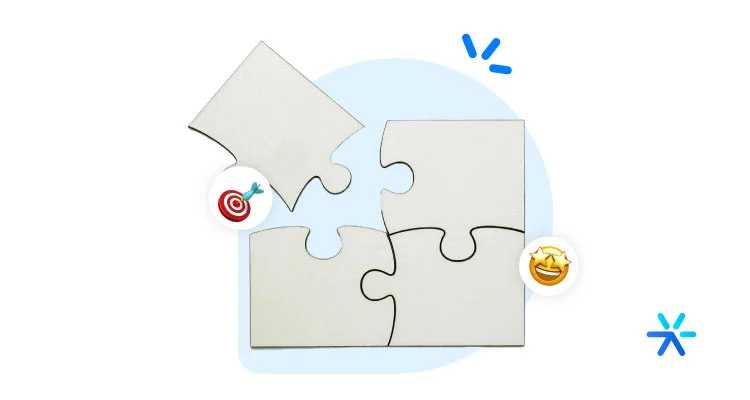What is Holistic Marketing and How to Start Doing It Today
It’s not every day that we come across the term “holistic marketing,” right? In fact, even the term holistic isn’t very common in our daily lives.
But don’t worry, because while this name may be outside of our everyday language, its concept is quite simple to understand.
Giving a brief spoiler of what we’ll see here, holistic marketing aims to integrate different areas of marketing around the same goal: growth.
See? Nothing supernatural here.
In other words: holistic marketing, although not so well-known, is already being applied by several companies, to a lesser or greater extent.
Want to know more about this concept and how to apply it to your strategy? Keep reading because we have a lot to discuss! 😉
What is Holistic Marketing?

To better understand this concept, let’s first understand what “Holistic” means.
Well, the word “holistic” comes from the Greek “holos”, which means “whole,” “entire,” or “complete.”
Therefore, we can say that “holistic” means something that considers the whole, the overall view of something.
Okay, so what about holistic marketing?
Think of holistic marketing as the functioning of the human body. We have different organs, systems, and cells, each with a different mission, but all work together and aligned for the organism to function well.
We are talking about a philosophy that considers the business as a whole, and furthermore, marketing as a set of tools that need to be fully explored.
In holistic marketing, the path to sales is a combination of philosophies and practical methodologies. Sometimes, from an external perspective, it’s even difficult to say exactly what works towards generating sales and what doesn’t.
Shall we delve deeper into the four pillars of holistic marketing to better understand?
What are the types of marketing included in holistic marketing?
Within holistic marketing, we have four other main types of marketing that make the concept work.
Of course, due to the holistic nature of this methodology, other strategies are often used as well.
However, these four types of marketing are considered the pillars of holistic marketing because they work as a minimum unit, the basics that holistic marketing needs to offer.
Check it out:
Sales Focus
Sales Marketing is a traditional strategy aimed at promoting the company’s products or services.
When applying this strategy in holistic marketing, this sales focus is balanced with other approaches to generate value and enhance the user experience.
This pillar includes terms such as sales funnel, digital marketing, offline marketing, outbound marketing, inbound marketing, etc. In other words, everything related to selling.
Relationship Focus
Relationship Marketing, on the other hand, is the strategy that creates and maintains lasting bonds between the company and its customers.
Relationship marketing values dialogue, transparency, personalization, post-sales service, and support teams.
It’s worth noting that in holistic marketing, relationships are essential to building a solid base of loyal and engaged customers.

Performance Marketing
Performance Marketing (paid media), in turn, is the data and metrics-based strategy that aims to maximize return on investment in marketing through advertising platforms – ROAS.
Performance marketing focuses on issues such as conversion optimization, A/B testing, remarketing, audience segmentation, and Google Analytics data analysis.
This foundation of holistic marketing serves to measure and optimize the results of other marketing approaches, as well as to identify opportunities for improvement and innovation.
Internal Marketing
Finally, we have Internal Marketing that engages and motivates the company’s employees through actions such as internal communication, training, recognition, benefits, and quality of work life.
Keeping your employees motivated and aligned with the company is a fundamental pillar for the success of your business.
For holistic marketing, Internal Marketing serves to align the company’s values and mission with the culture and expectations of its employees.
What are the advantages of holistic marketing?
Alright, besides keeping the company’s areas aligned, what are the other advantages of holistic marketing?
Well, I’ve outlined here 3 benefits that you can take advantage of with this strategy, check them out!
🔎 You may also like: AI in Digital Marketing – 30 useful examples
It consolidates various activities into one
In marketing, we always look for strategies, tools, websites, and platforms that can offer us more than one functionality, because this saves time, money, and keeps everything more organized.
Remember that the holistic name is the gathering of all marketing efforts that all companies need to make. In other words, it is advantageous because it shows that your company is doing everything it needs to do regarding marketing, and the best part: in an integrated way.
It helps maintain brand unity
If you integrate areas and keep all your employees aligned, you will have a consolidated and strong brand unity, with no room for communication gaps.
In other words, you will offer consumers a company with organized promotions, campaigns, strategies, branding, and other actions that always aim for the best user experience.
It levels the user experience
To close our trio of benefits, with holistic marketing, we have all customer or user experiences leveled.
In other words, the entire sales cycle, from the attraction phase to post-sales, is in constant balance, which benefits both the company and the consumer.
How to start doing holistic marketing?

To conclude our content in the best way, let’s understand how you can start doing holistic marketing in your company. 👇
Identifying marketing channels
The first step to implementing holistic marketing in your company is to analyze and identify which marketing channels you are already present on.
In other words, think about questions like: do you have a blog? Do you have a newsletter? Which social media platforms do you use? Do you practice inbound and/or outbound marketing?
Identify everything your company does so that you can think about how to integrate your actions from there.
Integration of all teams
Next, with the channels already identified, it’s time to integrate your teams. This integration varies from company to company, as you can opt for joint management between teams or want to have separate management reporting to a single director.
But, the important thing here is that all different teams are integrated, preferably in the same office.
Creation of production routines
With integrated teams, you can create production routines and align your communication.
In holistic marketing, campaigns are often integrated. Let’s take a real example: content marketing lead magnets, which generate new leads; these new leads need to be converted into sales, new customers entering create relationship opportunities, and so on.
Creation of integrated goals and KPIs
To conclude our step-by-step guide and close your holistic marketing strategy, you will need to create integrated goals and KPIs that will be responsible for measuring and analyzing your integrated campaigns and actions.
Think about, for example, how many leads were generated? And how many sales were generated from these leads?
So, are you ready to apply holistic marketing in your company? If you have any doubts, feel free to ask us in the comments. 😉
Thanks for reading, and be sure to check out our 14 day free trial. No credit card required – you’ll have your chatbot up and running in no time.








